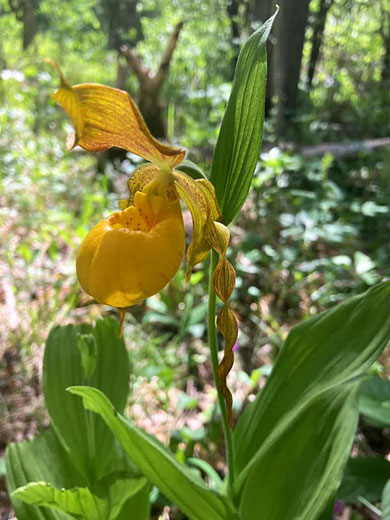Cypripedium Parviflorum, Yellow Lady's Slipper
Plants > Wildflowers > Orchidaceae > Cypripedium Parviflorum
Common name:
Yellow lady's slipper
Family:
Scientific name:
Cypripedium parviflorum
Main flower color:
Range:
The Rocky Mountain states, parts of the Great Plains, and most of the eastern states
Height:
Up to 2 feet
Habitat:
Fens, meadows, prairie, open woodland, forested slopes, from sea level to 9,500 feet
Leaves:
Alternate, ovate to lanceolate, up to 7 inches long; 2 to 5 per stem
Season:
April to August
Cypripedium parviflorum is found across a large geographical area though in the West it is always rare and localized; it is much more common east of the Great Plains. This is a variable species, due to the elevation range, the differing habitats, and its tendency to hybridize. Stems are typically between 1 and 2 feet tall, and the lower half bears between two and five leaves, usually with five veins. Flowers are produced singly or in pairs, at the top of the stem.
Sepals are unequal. The upper sepal is ovate, up to 3 inches long and 1.5 inches wide, green or yellowish, sometimes tinged reddish-brown, and not twisted. The two lateral sepals are fused, and angled downwards. The two lateral petals are similar in length to the upper sepal, or slightly longer, and similar in color, but (usually) twisted. The lower petal, the lip, is strongly pouched, usually yellow, rarely white, and sometimes with a few red dots on the upper surface.
There are three varieties of cypripedium parviflorum (makasin, parviflorum, pubescens), distinguished by petal and sepal characteristics.
Sepals are unequal. The upper sepal is ovate, up to 3 inches long and 1.5 inches wide, green or yellowish, sometimes tinged reddish-brown, and not twisted. The two lateral sepals are fused, and angled downwards. The two lateral petals are similar in length to the upper sepal, or slightly longer, and similar in color, but (usually) twisted. The lower petal, the lip, is strongly pouched, usually yellow, rarely white, and sometimes with a few red dots on the upper surface.
There are three varieties of cypripedium parviflorum (makasin, parviflorum, pubescens), distinguished by petal and sepal characteristics.
All Contents © Copyright The American Southwest | Comments and Questions | Contribute | Site Map

